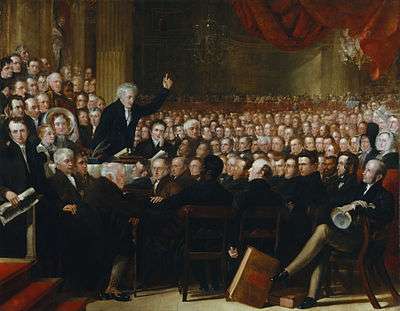Anti-Slavery Society

- ^ The Anti-Slavery Society Convention, 1840, Benjamin Robert Haydon, 1841, National Portrait Gallery, London, NPG599, Given by British and Foreign Anti-Slavery Society in 1880
The Anti-Slavery Society was the everyday name of two different British organisations.
The first was founded in 1823 and was committed to the abolition of slavery in the British Empire. Its official name was the Society for the Mitigation and Gradual Abolition of Slavery Throughout the British Dominions. This objective was substantially achieved in 1838 under the terms of the Slavery Abolition Act 1833.
A successor organisation, the British and Foreign Anti-Slavery Society, was formed in 1839 to fight for global abolition. After the end of slavery in the United States, the British organisation re-focussed. Through mergers and name changes, it is now known as Anti-Slavery International.
Precursors
The elimination of slavery throughout the world was frequently in the mind of early abolitionists. The Committee for the Abolition of the Slave Trade, which established the Society for Effecting the Abolition of the Slave Trade in 1787, campaigned for an end to the Transatlantic slave trade from Western Africa to the New World, which Britain dominated by then.
The Slave Trade Act 1807 made the trade illegal in the British Empire, but brought no change to the condition of enslaved people. Following this, British abolitionists turned their attention to abolishing slavery itself, first in British colonies, and later in the US and the colonies of other European powers (e.g., in South America), and in parts of the world where it had long been legal, such as in the Middle East, Africa, and China.
The Anti-Slavery Society of 1823
The first British organisation to refer to itself as the Anti-Slavery Society began in 1823. Founding members included William Wilberforce and Thomas Clarkson.[1] Its official name was the Society for the Mitigation and Gradual Abolition of Slavery Throughout the British Dominions.
Its work included supporting the first slave narrative to be published by a Black woman, Mary Prince, The History of Mary Prince, A West Indian Slave (1831). The publishers were sued by the family from which she had escaped. The book was much sought after, running into three editions in the year of its publication.
A wide range of views emerged among the members. Broadly, there were abolitionists who insisted on the full working out of the gradual process of abolition and amelioration (which had its successes), and the generally younger, more radical members, whose moral outlook regarded slavery as a mortal sin to be ended forthwith. Elizabeth Heyrick's 1824 pamphlet "Immediate, not Gradual, Abolition" gave the tone to the argument.
The latter group, including Joseph Sturge and many others, publicly campaigned throughout Britain. The idea was to engender public pressure for a new parliamentary act to outlaw slavery, rather than continue the gradualism of Whitehall's negotiations, mainly with colonial governments. In 1831 George Stephen and Joseph Sturge formed a ginger group within the Anti-Slavery Society, the Agency Committee, to campaign for this new act of Parliament. This campaign, and public pressure, led to the Slavery Abolition Act of 1833, though it contained compromises which they disliked.
The indentured labour schemes were particularly opposed by Sturge and the Agency Committee; the full working out of the Act would take several years, with slavery eventually being abolished throughout the British West Indies on 1 August 1838. In response to the new legislation, other members of the Anti-Slavery Society considered their work over. The original purpose, as reflected in the name of the society (abolition in the British dominions), had, they thought, been achieved.
The Anti-Slavery Society of 1839
With abolition of slavery throughout the British dominions achieved, British abolitionists in the Agency Committee of the Anti-Slavery Society considered that a successor organisation was needed to tackle slavery worldwide. Largely under the guidance of Joseph Sturge, the committee duly formed a new society, British and Foreign Anti-Slavery Society on 17 April 1839.[2][3] It became widely known as the Anti-Slavery Society, as had the earlier society.
The first secretary was John Harfield Tredgold, the first treasurer, George William Alexander of Stoke Newington. Along with the founding committee, which included the Anglican Thomas Fowell Buxton, the Quaker William Allen, and the Congregationalist Josiah Conder, they organised the first World Anti-Slavery Convention in London in 1840. Thomas Clarkson was the key speaker, and the Convention attracted people from nations around the world where slavery was practiced.
The convention had been advertised as a "whole world" convention, but the delegates representing anti-slavery societies in the United States included several women, among them Lucretia Mott and Elizabeth Cady Stanton, who later were instrumental in the movement for women's rights. Convention leaders refused to seat the women delegates from America, and prominent male abolitionists such as Thomas Knight were outraged. He went on to form his own society.
In the 1850s, under Louis Chamerovzow, the society helped John Brown write and publish his autobiography a decade before the American Civil War ended slavery in the United States.
The second secretary of the Anti-Slavery Society, appointed under the honorary secretaries Joseph Cooper and Edmund Sturge, was the Rev. Aaron Buzacott (1829–81), the son of a South Seas missionary also named Aaron Buzacott. With American slavery abolished in 1865, Buzacott worked closely with Joseph Cooper in researching and publishing work designed to help abolish slavery in elsewhere, particularly in the Middle East, Turkey and Africa.
Twentieth century and now
In 1909, the society merged with the Aborigines' Protection Society to form the Anti-Slavery and Aborigines' Protection Society, whose prominent member was Kathleen Simon, Viscountess Simon. In 1990 the name was changed to Anti-Slavery International.
See also
References
- ↑ "Slavery and abolition". Oup.com. Retrieved 2014-03-18.
- ↑ About Anti-Slavery International Archived 26 June 2010 at the Wayback Machine. antislavery.org
- ↑ Patricia Hollis (1974). Pressure from without in early Victorian England. p.39.
